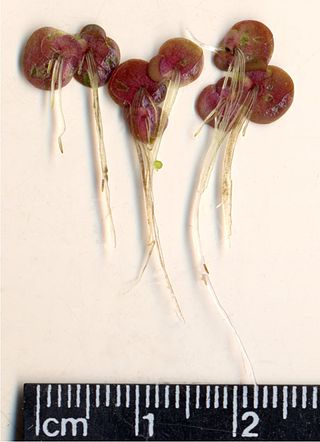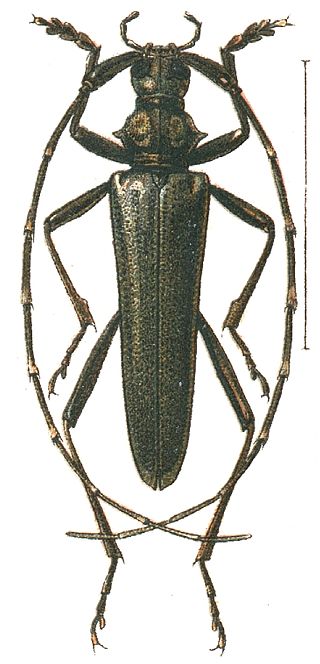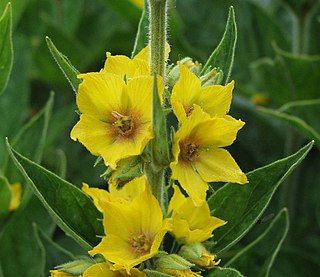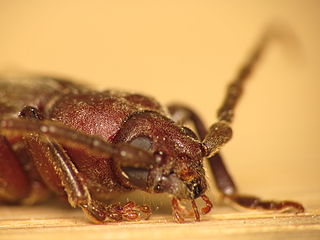
The longhorn beetles (Cerambycidae), also known as long-horned or longicorns, are a large family of beetles, with over 35,000 species described.

Lysimachia is a genus consisting of 193 accepted species of flowering plants traditionally classified in the family Primulaceae. Based on a molecular phylogenetic study it was transferred to the family Myrsinaceae, before this family was later merged into the Primulaceae.

Spirodela is a genus of aquatic plants, one of several genera containing plants commonly called duckweed. Spirodela species are members of the Araceae under the APG II system. They were formerly members of the Lemnaceae.

The Chrysomeloidea are an enormous superfamily of beetles, with tens of thousands of species. The largest families are Cerambycidae, long-horned beetles, with more than 35,000 species, and Chrysomelidae, leaf beetles, with more than 13,000 species.

Globularia is a genus of about 22 species of flowering plants in the family Plantaginaceae, native to central and southern Europe, Macaronesia, northwest Africa and southwest Asia. They are dense low evergreen mat-forming perennials or subshrubs, with leathery oval leaves 1–10 cm long. The flowers are produced in dense inflorescences (capitula) held above the plant on a 1–30 cm tall stem; the capitula is 1–3 cm in diameter, with numerous tightly packed purple, violet, pink or white flowers.

Eucalyptus punctata, commonly known as grey gum, is a small to medium-sized tree that is endemic to eastern Australia. It has smooth grey bark that is shed in patches, lance-shaped, curved or egg-shaped adult leaves flower buds in groups of seven, white flowers and hemispherical or cup-shaped fruit. Its leaves are one of the favoured foods of the koala.

Spirodela punctata is a species of duckweed (Lemnoideae). The species is morphologically intermediate between Lemna and other species of Spirodela. In 1999 D.H. Les and D.J. Crawford proposed segregating the species to a new genus Landoltia containing just the species L. punctata, on the basis of biochemical and DNA studies.

The Indian flapshell turtle is a freshwater species of turtle found in South Asia. The "flap-shelled" name stems from the presence of femoral flaps located on the plastron. These flaps of skin cover the limbs when they retract into the shell. It is unclear what protection the flaps offer against predators. Indian flapshell turtles are widespread and common in the South Asian provinces. It is morphologically an evolutionary link between the softshell and hardshell aquatic turtles. Exploitation for profit and habitat change are threats to their survival.

Psyllobora vigintiduopunctata, the 22-spot ladybird, is a common, 3–5 mm long ladybird native to Europe. The elytra are yellow in colour with 22 black spots. The pronotum is yellow or white with 5 black spots. Unlike most other ladybirds which feed on aphids, P. 22-punctata eats mildew — especially from umbellifers and low-growing shrubs . The 22-spot ladybird is best looked for amongst low vegetation.

The Disteniidae are a small family of beetles in the superfamily Chrysomeloidea, traditionally treated as a group within the Cerambycidae.

Lysimachia punctata, the dotted loosestrife, large yellow loosestrife, circle flower, or spotted loosestrife, is a flowering plant species in the family Primulaceae.

Persicaria punctata is a species of flowering plant in the knotweed family known by the common names dotted smartweed and dotted knotweed.

Saperda punctata is a beetle species of flat-faced longhorns belonging to the family Cerambycidae, subfamily Lamiinae.

Asemini is a tribe of beetles in the subfamily Spondylidinae, containing the following genera and species:

Dysauxes punctata is a moth of the family Erebidae. It was described by Johan Christian Fabricius in 1781. It is found in France, Portugal, Spain, Switzerland, Austria, Italy, Croatia, Bosnia and Herzegovina, North Macedonia, Greece, Turkey, Romania, Ukraine, Russia and North Africa.
Oryza punctata is an annual grass in the rice genus Oryza, also known as red rice, related to cultivated rice O. sativa. O. punctata forms clumps or tussocks from 50–120 cm tall. It is a native to tropical Africa and Madagascar but is also found in Thailand and other parts of Indochina. O. punctata is a weed species in commercial rice growing operations although it appears to be rare in its native range. O. punctata has an IUCN status of least concern. It is not generally eaten or used as fodder by farmers but there is some evidence that it has been used as such during periods of famine. Due to the importance of the crop varieties of rice globally, the evolution of the Oryza genus as a whole has been studied extensively. A lot of information about O. punctata has been elucidated as a secondary benefit to this commercial research. O. punctata evolved some 5 million years ago in the second of two rapid radiation events that occurred in the Oryza L. genus.

Gentiana punctata, the spotted gentian, is a least concern herbaceous species of flowering plant in the Gentian family Gentianaceae. It grows in Central and Southeastern Europe at altitudes 1.500−2.600 meters. It is 20−60 cm tall.
The field elm cultivar 'Punctata' ['spotted', the leaf] first appeared in the 1886–87 catalogue of Simon-Louis of Metz, France, as U. campestris punctata. It was distributed by the Späth nursery, Berlin, in the 1890s and early 1900s as U. campestris punctataSim.-Louis, the Späth catalogue listing it separately from U. campestris fol. argenteo-variegata and from U. campestris fol. argenteo-marginata. Green considered it possibly a synonym of the Field Elm cultivar 'Argenteo-Variegata'.

Nothorhina is a genus of beetles belonging to the family Cerambycidae.

Brachyta punctata lazarevi is a species of beetle in the family Cerambycidae. It was described by Danilevsky in 2014. It is known from North Korea.


















